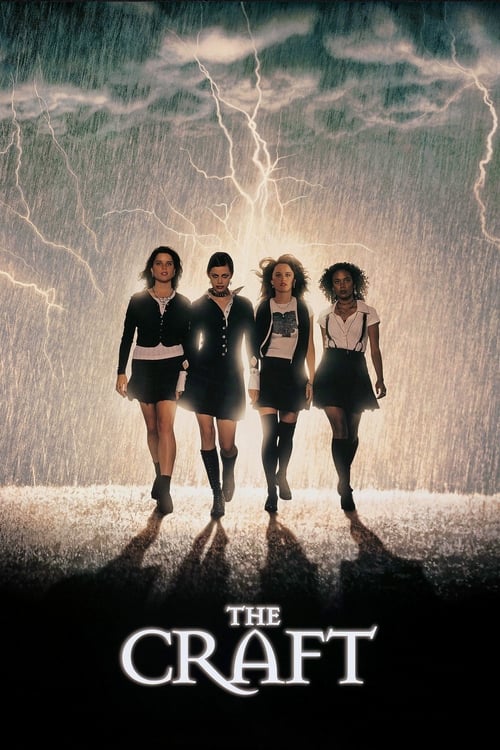The Craft – Film Review
Published September 1, 2023

After transferring to a Los Angeles high school, Sarah finds that her telekinetic gift appeals to a group of three wannabe witches, who happen to be seeking a fourth member for their rituals. Bonnie, Rochelle and Nancy, like Sarah herself, all have troubled backgrounds, which combined with their nascent powers lead to dangerous consequences. When a minor spell causes a fellow student to lose her hair, the girls grow power-mad.
The Craft, directed by Andrew Fleming and released in 1996, is a film that has enchanted audiences for decades with its unique blend of teenage drama, witchcraft, and dark themes. This cult classic has carved out a special place in the hearts of many viewers, and for good reason. With its compelling characters, thought-provoking themes, and remarkable performances, The Craft remains a captivating and relevant exploration of the complexities of adolescence and the power of friendship.
The story follows Sarah Bailey (Robin Tunney), a troubled newcomer to a Los Angeles high school who quickly falls in with a group of outcasts: Nancy Downs (Fairuza Balk), Bonnie (Neve Campbell), and Rochelle (Rachel True). All four girls are drawn together by their shared interest in witchcraft, but they each bring their own unique struggles and desires into the coven.
The film does an excellent job of weaving together the supernatural elements of witchcraft with the very real challenges of teenage life. It explores themes of identity, power, and friendship with depth and nuance. The script, penned by Peter Filardi and Andrew Fleming, effectively captures the struggles of adolescence, the desire for acceptance, and the consequences of seeking power without responsibility.
One of the film’s strengths is its ability to balance moments of intense supernatural suspense with the emotional development of its characters. The evolution of the coven from naive beginners to powerful practitioners is skillfully portrayed, keeping the audience engaged throughout. However, the pacing could have been improved in certain areas, as there are moments when the film feels a bit rushed, hindering the depth of character development.
The Craft excels in its portrayal of complex, multi-dimensional characters. Sarah Bailey, played by Robin Tunney, is the heart of the story. Her character undergoes a transformation from a lonely, introverted girl to a confident and empowered young woman. Tunney’s performance is convincing, capturing the internal struggle and growth of her character effectively.
Fairuza Balk delivers a standout performance as Nancy, the group’s charismatic and unhinged leader. She embodies the character’s descent into madness and obsession with power, making her both compelling and frightening. Neve Campbell and Rachel True also give strong performances, infusing depth into their respective characters.
The relationships among the four young women are at the core of the film. Their dynamics are portrayed with authenticity, showing the ups and downs of teenage friendships. The film succeeds in depicting the complexity of their bond and the consequences of their actions, both magical and personal.
Andrew Fleming’s direction and Alexander Gruszynski‘s cinematography work hand in hand to create a visually engaging film. The use of lighting, camera angles, and visual effects effectively enhance the eerie and mystical atmosphere surrounding the witches’ rituals. The scenes involving magic are visually captivating and add an element of suspense to the narrative.
The film’s depiction of the supernatural elements is well-executed within the constraints of its budget. The special effects may appear somewhat dated by today’s standards, but they still manage to convey the magic and mysticism central to the story effectively. The use of practical effects and makeup to showcase the consequences of the girls’ actions adds a visceral and disturbing quality to the film.
One of the most compelling aspects of The Craft is its exploration of themes relevant to both teenagers and adults. It delves into issues such as bullying, body image, racism, and abuse, all of which resonate strongly with the experiences of its teenage characters. The film is unafraid to tackle these dark themes head-on, making it a thought-provoking piece of cinema.
The central theme of power and its corrupting influence is brilliantly depicted through the characters’ experiences with witchcraft. It serves as a metaphor for the choices and consequences that come with gaining power in any form. The Craft offers a cautionary tale about the dangers of seeking power without responsibility or empathy.
The film’s soundtrack deserves special mention, as it plays a pivotal role in enhancing the overall atmosphere. Featuring a mix of ’90s alternative rock and gothic tracks, the music perfectly complements the film’s dark and rebellious tone. Songs like “Tomorrow Never Knows” by Our Lady Peace and “How Soon Is Now?” by Love Spit Love are expertly chosen and add depth to the emotional landscape of the story.
The Craft remains a cult classic that has stood the test of time due to its compelling characters, themes, and the genuine exploration of teenage struggles. While it has its pacing issues and some dated effects, the film’s strengths far outweigh its weaknesses. It’s a dark and captivating journey into the world of teenage witchcraft that continues to enchant new generations of viewers. If you haven’t experienced the magic of The Craft, it’s well worth a watch, especially if you’re drawn to films that delve into the complexities of youth, power, and friendship.
